TL;DR:
The IOTA Foundation is proposing to rebase IOTA’s Layer 1 to introduce a protocol with full decentralization, L1 programmability with MoveVM and EVM support, 50k+ TPS scalability, and $IOTA staking. This upgrade offers a faster path to a new mainnet than current IOTA 2.0 plans. A governance vote will decide whether to adopt this protocol or continue with the current network. If approved, the new mainnet could launch after a testnet phase, security audits, and exchange integrations, unlocking advanced programmability to better meet industry demands and accelerate ecosystem growth.
It will soon be nine years since IOTA was first announced to get blockchain adopted in the real world. IOTA was founded not just to create a better blockchain without the need for miners, wasteful energy consumption, and exorbitant fees, but also to be the trusted infrastructure to digitize our global economy. Since its inception, IOTA has been driven by a vision of creating a connected and trusted world without digital barriers, empowering people all around the world to participate and benefit from our global economy.
Very early on, IOTA made it its mission to research alternatives instead of iterating on the existing but flawed concepts available at the time. The IOTA Foundation, the German non-profit organization behind IOTA, has been instrumental in realizing this vision by being a trusted partner for governments and institutions wanting to work with IOTA. The Foundation has grown to become one of the most experienced and academically respected R&D organizations with a 140-person team advancing the theoretical and practical work behind blockchain protocols and networks.
Built on a strong technical foundation with a scalable parallelized ledger, IOTA’s ambitions and commitment to real-world adoption projects have always been the key differentiator from the other Layer 1s (L1) out there. IOTA has led the ideation and creation of novel use cases across various industries such as mobility, trade and logistics, energy, and finance and we’ve worked closely with dozens of large enterprises, institutions, and governments on new blockchain-based applications.
While some of the use cases began as MVPs and pilots, several have evolved into real products and entire ecosystems of their own, on path to bring millions of transactions, users, and tokenized assets to the IOTA mainnet.
To highlight a few of our key adoption cases that have matured into real solutions over the years:
- Being a finalist in the European Blockchain Service Infrastructure (EBSI) Pre-Commercial Procurement by the European Commission.
- Selection for the European Blockchain Sandbox with our tokenized on-chain KYC solution.
- Becoming the first DLT foundation registered with the Abu Dhabi Global Market.
- Co-founding a governing entity to digitize trade infrastructure with organizations including the World Economic Forum, the Tony Blair Institute for Global Change, the Institute of Export and International Trade, and the Global Alliance for Trade Facilitation.
- Running trade lanes between the UK and Kenya facilitated by the UK Cabinet Office and collaborating with entities like Mobius Technology and Technology-Enabled Trading Alliance.
- Being used as the underlying DLT for EnergieKnip and MultiKnip, two Netherlands-based digital wallets that incentivize and reward sustainable energy consumption.
- Developing trust and accountability technology for SECANT (Security and Privacy Protection in Internet of Things Devices) in an EU-funded international collaboration between healthcare and security tech organizations.
- Working with the city of Trondheim, Norway, to tackle sustainable development goal challenges in smart cities
Our partners across industries and governments choose to work with IOTA not just because of our technical innovations; but they choose to work with IOTA because of our long-standing reputation as a serious and trustworthy R&D organization, our regulated non-profit foundation based in reputable jurisdictions (Germany, Switzerland, and the UAE), our experienced team, our values and principles and our strong vision for the future. Trust in a new technology ecosystem is not implied: it needs to be earned and retained over time.
A New Era of Growth
Today’s blockchain users take the underlying infrastructure largely for granted, demanding that it “just works”. Most of the technological building blocks of blockchains have largely been commoditized, with faster confirmation times, smaller transaction fees, greater decentralization, or lower latency yielding negligible differences for the end users. To differentiate and to succeed it is no longer just about creating novel technologies, but about building ecosystems and applications that drive adoption and utility.
This is why we, at the IOTA Foundation, want to share how we want to accelerate the adoption of IOTA by rebasing the Layer 1 (L1) IOTA protocol on a new protocol that we call “IOTA Rebased”.
IOTA Rebased would significantly shorten our time to market to introduce programmability and full decentralization to IOTA. We believe that this direction has the best chance of leapfrogging IOTA and creating significant value for its token holders, and ecosystem. This proposal will be subject to an upcoming community governance vote.
IOTA’s Coordicide and Decentralization
IOTA’s path to decentralization was dedicated to removing the Coordinator, a central node that assisted the network in validating transactions by issuing periodic milestones. While the Coordinator was effectively replaced with a distributed validator committee in 2023 through the Stardust protocol upgrade, our team has always aspired to fulfill the original vision behind IOTA.
Having introduced the first DAG-based distributed ledger protocol in 2015 with the Tangle, it was a challenging research and engineering effort to define an entirely new protocol that would be fully decentralized, feeless for token holders, and offer a leaderless consensus for anyone to participate in validating the network. Over the years our team has worked tirelessly on the protocol and the research behind it. In total, over 65 research publications were published and the node software was written entirely from scratch. After several iterations, we delivered a fully functional IOTA 2.0 testnet with node software, wallet, and explorer in April 2024.
IOTA 2.0 has achieved its goal of creating a fully decentralized IOTA protocol, removing not only the coordinator but creating a leaderless consensus protocol with feeless transactions for token holders. However, when looking at the needs of industry partners and builders, IOTA 2.0 only represents an intermediate step to the much bigger and more important need for L1 smart contracts.
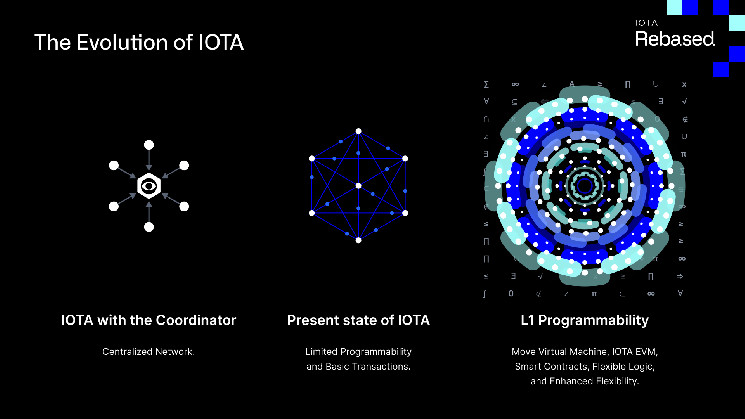
IOTA’s value creation will be primarily enabled through the programmability of the ledger with new use cases, applications, and utility. Without L1 smart contracts, the protocol’s utility and usage would be limited purely to token transfers. Decentralization, while an important puzzle piece, does not automatically enable adoption; rather, programmability does. This is why in 2021 our team started prioritizing programmability on IOTA.
IOTA’s Journey to Programmability
To meet the growing demand for smart contracts on IOTA, our team has invested in two distinct efforts since early 2021:
- IOTA Smart Contracts Protocol (ISC), started in 2021 (see the whitepaper here) to introduce EVM-based smart contracts on IOTA as an L2 solution.
- IOTA Layer 1 Smart Contracts to bring smart contracts directly to IOTA’s L1 protocol.
The integration of EVM-based smart contracts was successfully concluded with the official launch of the IOTA EVM in May 2024. Many projects including LayerZero, Stargate, Pyth, Goldsky, and over 30 native dApps have successfully deployed on the network since its launch. With this release, IOTA can finally begin to compete in Web3 and bootstrap an entire ecosystem of new applications, liquidity, and users on IOTA.
Alongside the development of the IOTA EVM, we also created an internal team in 2022 to assess the solution landscape and technical feasibility of integrating smart contracts into IOTA’s L1. This initial work concluded in February 2023 with options and recommendations on how to proceed.
The primary conclusion was that, out of all available solutions, the Move Virtual Machine is the most applicable and most promising solution for IOTA’s DAG ledger considering its architecture, features, safety, and future potential. Considering the various similarities between our protocols, properties, and objectives, the team concluded that the work of the Sui team (Mysten Labs), its MoveVM, and ledger architecture was the most promising and appropriate to adapt to IOTA.
Following the internal recommendation, our team worked on an initial prototype porting the Sui MoveVM to IOTA, which helped us to understand the intricacies of the protocol and the requirements for porting it to IOTA. This work was concluded in December 2023 with the completion of a functional prototype.
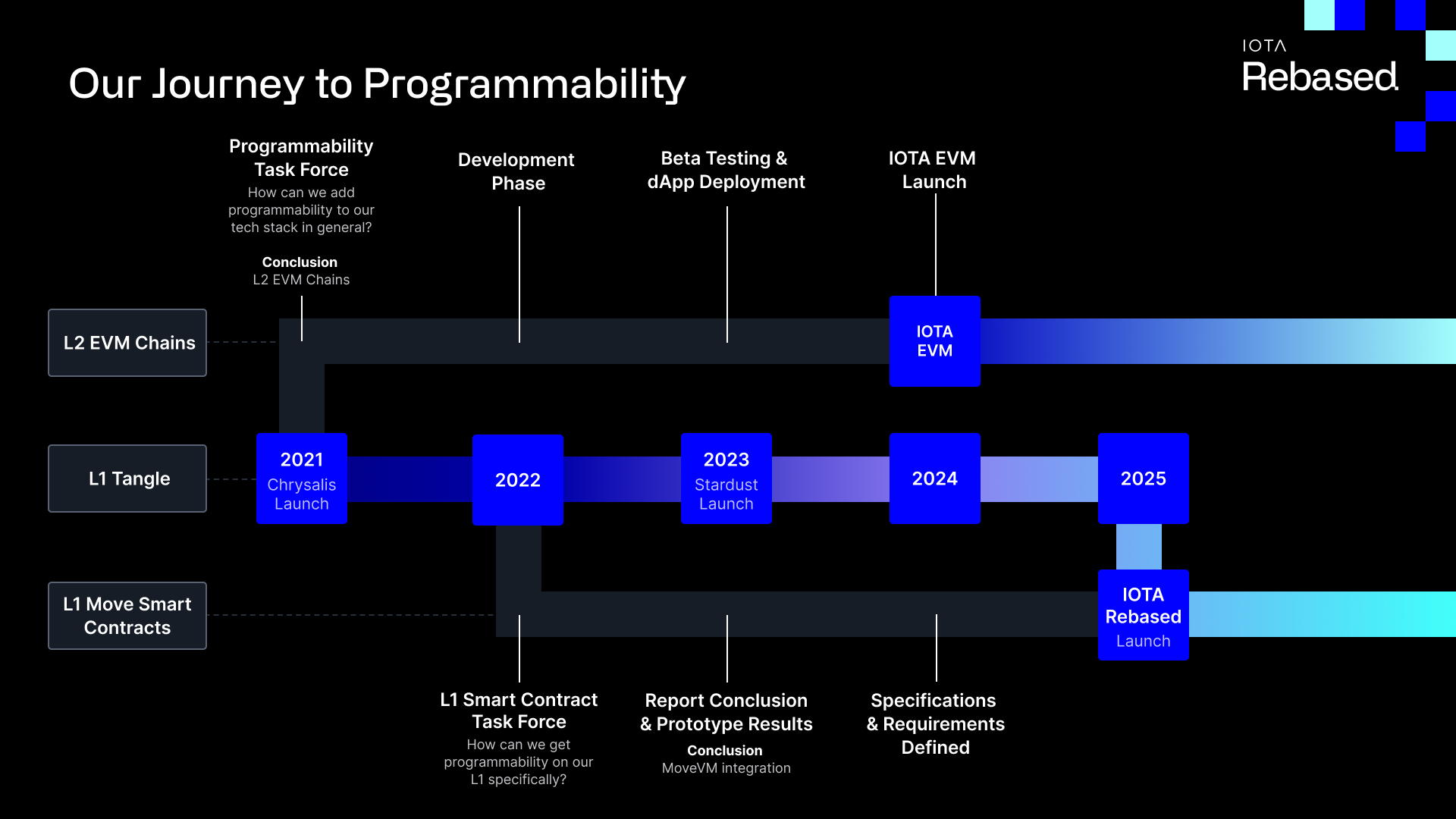
Our smart contract team then began to work with the IOTA 2.0 core team on the requirements and specifications of bringing MoveVM to the IOTA 2.0 protocol. Their initial assessment concluded that, while technically feasible, implementing MoveVM into IOTA 2.0 would be a multi-year effort to deliver a safe and tested protocol to the mainnet. Moreover, this approach would require two consecutive breaking protocol changes: first for IOTA 2.0, and later for the L1 Move upgrade. Such frequent breaking updates would be a major hindrance to IOTA’s efforts on real-world adoption and the general growth of our ecosystem.
This is why our team began to work intensely on IOTA Rebased as an alternative to this option, and we are happy to share this new protocol with a full testnet release today.
Fast Forward with IOTA Rebased
The demands of our ecosystem and industry partners for IOTA are to be a scalable, reliable, and programmable blockchain infrastructure to power their applications and use cases. Instead of spending several years to deliver on this promise, we want to deliver a scalable and programmable network within a drastically shortened time frame.
With IOTA Rebased, we leverage our close to 10 years of experience operating in the blockchain market and building unique relationships with enterprises, governments, and regulators around the world to accelerate our mission to make IOTA a leading global infrastructure that brings the real-world on-chain. IOTA Rebased offers the opportunity to leapfrog and focus on what matters most for IOTA by getting adoption and increasing token utility.
IOTA Rebased delivers this promise to IOTA and helps us achieve significantly faster time to market and maturity of our technology stack. It would allow us to scale up our adoption efforts and support our ecosystem to build a new wave of applications that drive significantly more value to IOTA.
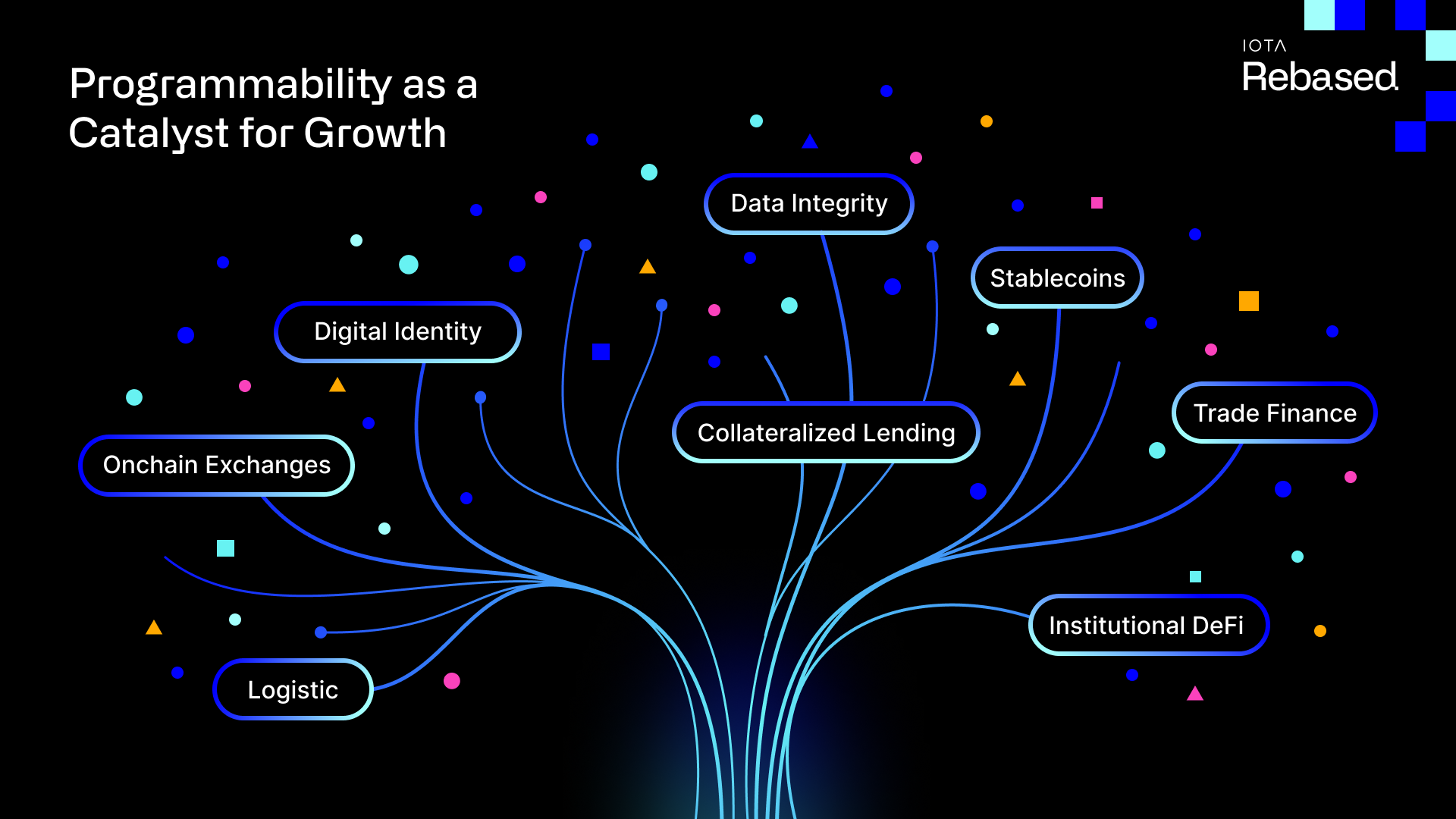
Just some examples of what will be possible with IOTA Rebased:
- With TLIP we’re currently digitizing the transport of goods (flowers, coffee, etc.) in Kenya and are in pilot stages in several other countries. The next step will be to tokenize the value chain, including tokenizing physical assets and financial ones (e.g. invoices) to create an entire trade finance ecosystem on IOTA. This will not only unlock huge opportunities for commercial traders to receive instant funding thanks to DeFi, but it will also bring real assets and value on-chain to IOTA.
- We are working with Realize to tokenize yield-bearing assets and to make them accessible to any investor around the world. While it is currently possible to build a marketplace for tokenized assets on the EVM, the team at Realize wants to build a fully decentralized on-chain order book DEX. This requires the IOTA L1 to be capable of performing several thousand transactions per second and to be fully programmable.
- Digital Product Passports, which we are currently tokenizing with NFTs, will not just be used as a certificate and proof of origin but as collateral in collateral-backed lending platforms, relying on a Layer 1 programmability.
- We are working to onboard stablecoins to be minted natively on the IOTA network. This requires them to have programmability on the L1 so the stablecoin operators can mint and burn stablecoins, and introduce compliance-related functions.
- The introduction of staking will support the creation of Liquid Staking Tokens (LSTs) to further fuel the growth of the ecosystem by allowing IOTA tokens to secure the network (L1), while also being productively used as collateral within DeFi.
Instead of adapting MoveVM to IOTA 2.0 in a multi-year effort, we want to use the best available solutions on the market today and merge them with the vision and principles behind IOTA to accelerate our adoption.
When assessing the options of IOTA Rebased we took great inspiration from Sui. Thanks to significant investment by Facebook (now Meta) into the technology (where it originated), they have delivered one of the most promising new smart contract paradigms with Move. We want IOTA to be part of the Move ecosystem and advance the adoption of Move in Web3 and across industries.

IOTA Rebased will be a new protocol that combines the best tried-and-tested innovations in the DLT space. The ledger would be an object-based DAG ledger running on a Delegated Proof of Stake (DPoS) consensus (Mysticeti). We will enhance this ledger with improved and more sustainable tokenomics, designed to guarantee a long-term viable economic model and to ensure the security and stability of the network. While this protocol will have fees, they are decreased to a level where the fee is negligible, which in turn can be recouped through staking and other yield opportunities. A fee-burning mechanism similar to Ethereum and Solana, and staking rewards for network delegators and validators will become key features of this new protocol.
On L1, we will have Move-based smart contracts which will introduce our ecosystem to a new application paradigm. On L2, we will continue to support the IOTA EVM to make it seamless for applications to deploy and be successful on IOTA.
While we’re considering adopting established technology as our new base, we’re already working on enhancements that would be shipped subsequently to set IOTA apart in the blockchain landscape. These improvements include:
- Improved consensus algorithm that promises to deliver enhanced security and efficiency.
- Introduction of local fee markets, designed to optimize network economics and user experience.
- Sponsored transactions to make it possible for operators of applications to offer feeless transactions to their users.
- Reimagined approach to gas fee calculations, structured to provide more predictable and fair transaction costs.
- Enhanced validator committee selection algorithm that creates a fairer point of entry and further decentralizes the network.
- Transitioning to a MultiVM ledger by supporting the EVM (and possibly other VMs) natively on the L1 network.
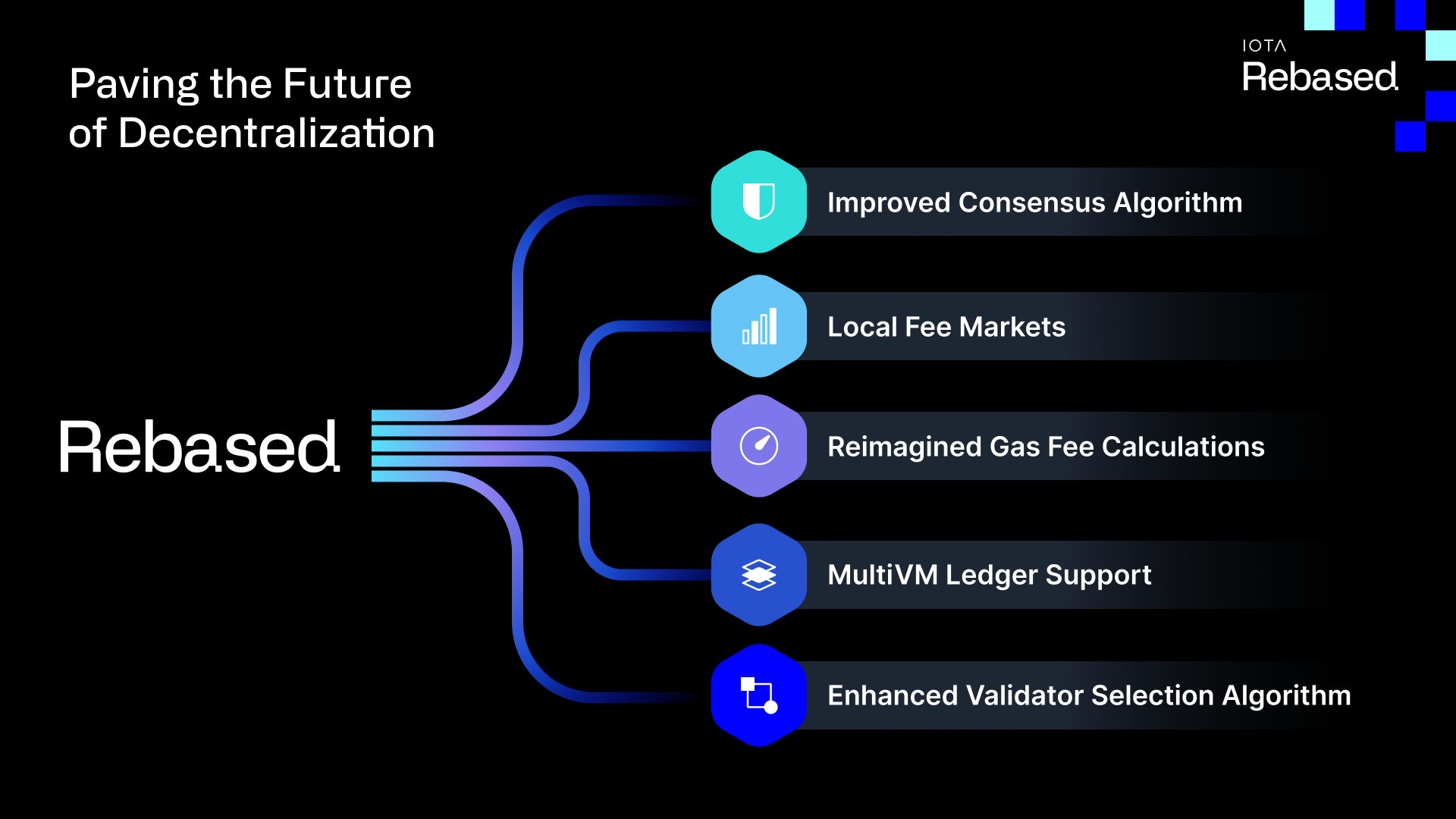
Through the Rebased protocol, IOTA and its ecosystem would immediately access a new application paradigm through L1 smart contracts, fully decentralized, and much-improved tokenomics, including attractive staking rewards for token holders securing the network. By combining the MoveVM and EVM, we would empower builders in our ecosystem to create entirely new applications. And with programmability on the L1, we would open up IOTA to limitless new applications that introduce new utilities such as ZK verification and new cryptography.
A summary of the major features of the new IOTA Rebased protocol apart from Move-based smart contracts:
- Move-based smart contracts on a parallelized DAG-based ledger.
- Full decentralization of the IOTA L1 DAG through a delegated proof of stake mechanism with 150 permissionless validator slots.
- Consensus switch to the Mysticeti protocol for high scalability and low latency, achieving upwards of 50k+ TPS and less subsecond finality.
- Very low transaction fees with an adaptive fee burn mechanism leading to a flexible supply (inflationary/deflationary).
- Sponsored transactions abstracting transaction fees away (possibly even feeless) from the user to significantly improve the user experience.
- Ability to earn staking rewards in IOTA tokens for token holders that secure the protocol through staking and delegation.
- Initial target inflation of 6-7% per year issued to reward stakers and validators, yielding 10-15% APY in staking rewards.
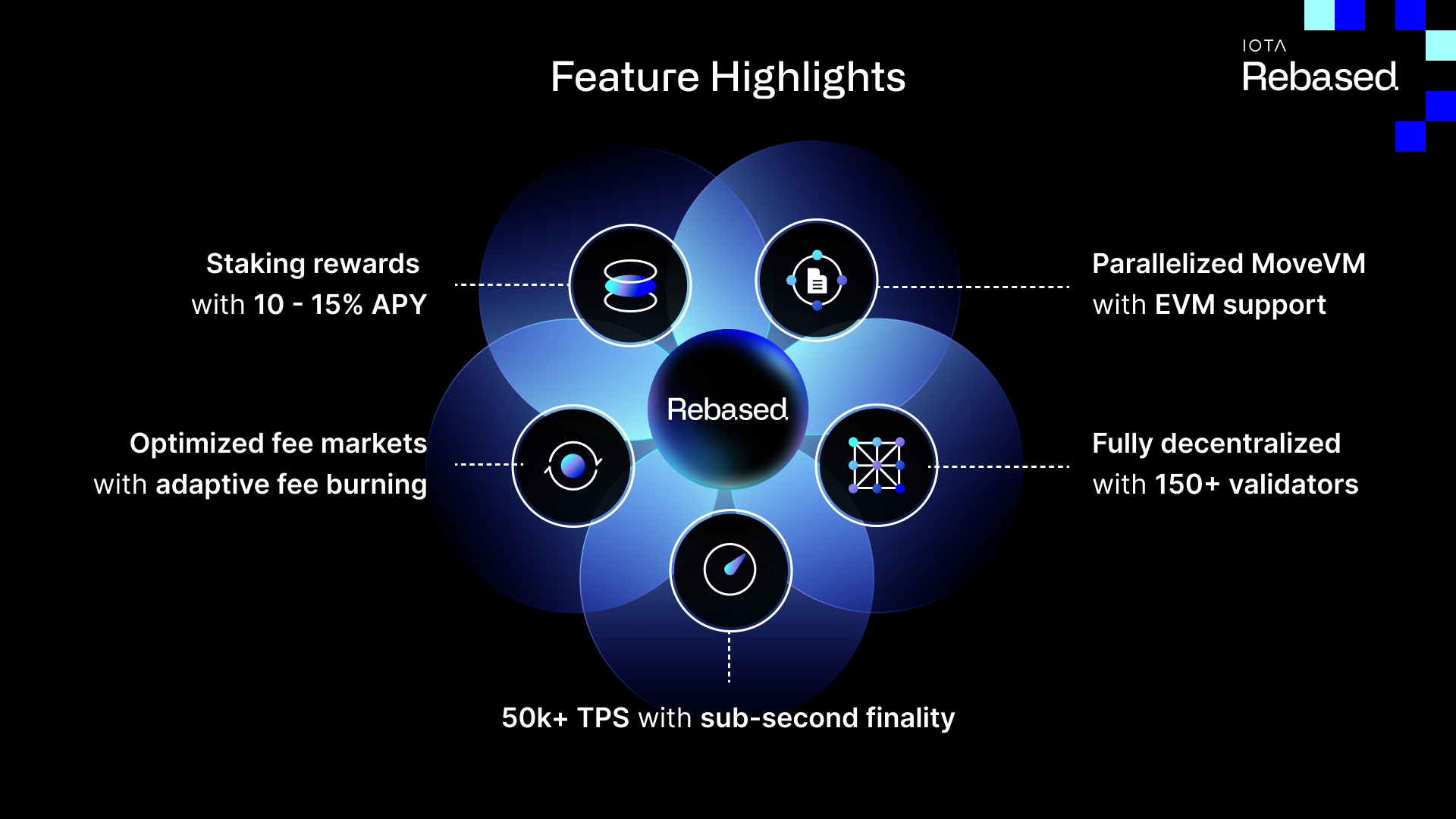
Alongside this proposal, we launched the IOTA Rebased testnet today, allowing the community to try it out now. To learn more about the IOTA Rebased protocol, you can read up on the details here:
- IOTA Rebased Technical View blog post
- IOTA Rebased Testnet and DevNet guide
This new protocol would allow the IOTA Foundation and its research partners to introduce significant new features and improvements later. Many of the ideas and lessons from IOTA 2.0 will find their way into the new protocol. More importantly, it would allow us to focus on new ways to make IOTA the best network for builders and users by improving onboarding, user experience, and utility immediately, and not only in several years.
After sufficient testing, the IOTA Rebased protocol will go straight to the IOTA mainnet. The Shimmer network would therefore not be upgraded with IOTA Rebased first. Furthermore, IOTA Rebased comes with convenient protocol upgrade features, making it much easier to improve the protocol and thereby making Shimmer as a staging network redundant. This offers Shimmer the possibility to pursue a different strategy to differentiate from IOTA and take a more unique role in the ecosystem. If the community votes for IOTA Rebased, the Shimmer network would continue to exist but cease to act as a staging network for the IOTA network.

IOTA Rebased represents a fundamental shift. It would alter the L1 of IOTA and introduce a new protocol that would deliver decentralization and Move-based Layer 1 smart contracts as quickly as possible. Instead of investing resources into a multi-year effort to adapt IOTA 2.0 with MoveVM, we are proposing to rebase our L1 with a new protocol that will introduce significant improvements to IOTA’s tokenomics, programmability, and attractiveness for builders. The testnet released today is already fully functional and contains all the aspects we would want IOTA Rebased to contain.
Therefore, in a best-case scenario, we’re confident that the IOTA mainnet could be upgraded with this new protocol relatively quickly after the conclusion of the initial testnet phase and the integration by major exchanges.
To decide on the future of IOTA, we are therefore asking the IOTA community and all token holders to participate in the protocol governance vote to:
- a) Approve the upgrade to a new protocol for IOTA.
- b) Reject the protocol upgrade, allowing the IOTA network to continue running as is, with the IOTA Foundation deciding on future development and stewardship.
We have created a governance post so the community can discuss and debate the protocol upgrade. The vote will officially go live on December 2nd.
Leapfrogging with IOTA
We believe that IOTA Rebased offers an exciting and critical opportunity to leapfrog the roadblocks in IOTA’s journey toward becoming a leading global infrastructure. If adopted, IOTA Rebased would drastically increase IOTA’s utility and accelerate IOTA’s competitiveness, providing a quicker and more efficient path than our original IOTA 2.0 plans. With its Move-based smart contracts and scalable, object-oriented ledger inspired by Sui, IOTA Rebased ensures that programmability and decentralization – essential to real-world adoption –– are achieved faster. This streamlined approach empowers us to meet the growing demands of industries and developers sooner, opening up new possibilities for IOTA’s ecosystem.
Internally, we’ve spent considerable time evaluating options and avenues, debating the future of IOTA, and concluded that the proposal for IOTA Rebased is the best way forward, benefiting everyone most. We are happy to present this proposal for a community governance vote and eager to learn what the community thinks about it. We encourage all IOTA token holders to participate in the upcoming vote. By supporting IOTA Rebased, you’ll help shape the future of IOTA and position it to seize new opportunities in the rapidly evolving digital economy.
If accepted by the community, the IOTA Rebased protocol could be released as the new IOTA Mainnet if the following conditions are fulfilled:
- Minimum two months testnet phase, including a thorough stress test.
- Readiness review of all real-world validators on the testnet.
- Completion of security audits during that phase.
- Integration of IOTA Rebased by major exchanges.
Let’s fast forward.
Read More
IOTA Rebased: Technical View
 iota-news.com
iota-news.com